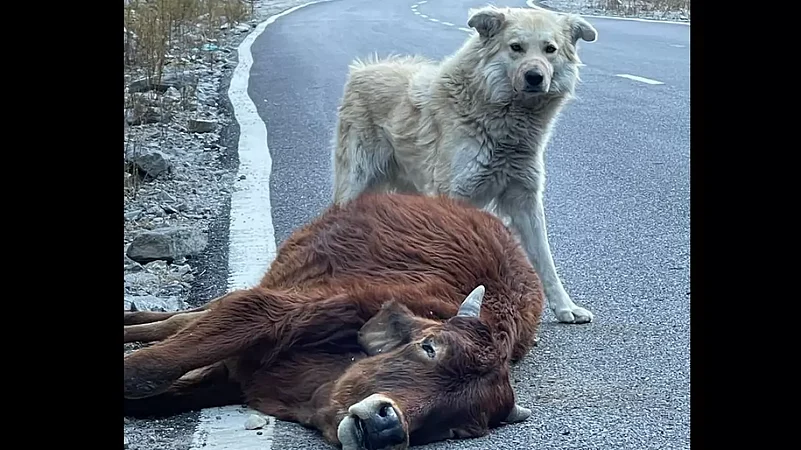I still remember the story that my grandfather once told me. He was a captain in the British Indian Army during the Second World War. His major, a British Officer on the Indo-Afghan border near Landi Kotal, had a pet Labrador. The dog followed the major everywhere, including on his many walks on the dangerous frontline. The major adored his pet.
The major was transferred back to England and had to make the long ship journey back home. He wasn’t sure whether he could take his pet dog along. It was a long shot that his dog would survive the ship journey. He was not confident that he would be able to find any owner who would give the same amount of love that his pet was used to.
So, he did the unthinkable, and as per the current Animal Birth Control (Dogs) Rules, 2001, completely illegal. As a child, I was traumatised by the cruelty of the major as our entire family had pet dogs and we adored them.
After five decades of reflection, I now have a new perspective.
India: An Endemic for Rabies
As per the World Health Organisation (WHO), India is endemic for rabies and accounts for 36 percent of the world’s rabies death. While the true burden of rabies in India is not known, as per the available information, it causes 18,000-20,000 deaths every year.
Man’s best friend accounts for forty-five times more human deaths than all large wild mammals in our forests. This includes Jim Corbett’s man-eating tigers. Between 2014 and 2018, 430-450 people were killed by wild tigers, leopards, and elephants. Between 2019 and 2021, 108 people were killed by tigers alone. The deaths due to street dogs are much higher.
India’s stellar public health system has eliminated smallpox and polio, but not rabies.
The Animal Birth Control (Dogs) Rules, 2001, have been enacted under Section 38 of the Prevention of Cruelty to Animals Act, 1960 to reduce the dog population by sterilisation and minimisation of stray dogs with the support and assistance of animal welfare organisations, private individuals and local authorities. The rules were established to treat animals with care and compassion and in a humane manner to achieve the objective of gradual reduction and stabilisation in the population of stray dogs on a long-term basis.
Why is India dealing with the street dog menace? Has the lack of the enforcement of Animal Birth Control (Dogs) Rules, 2001 and sterilisation caused the problem of street dogs and consequently, rabies?
Street Dog Menace in India
When I was studying in England, I was surprised to see how dog-loving the English were. I would come across many dog owners who would walk their dogs in parks and on the streets, but there were no “street dogs”. I spoke to many people who had dogs and they said they never had a pedigree dog. Rather, they adopted dogs from kennels. The reason why there were no street dogs.
As per a report titled ‘The Menace of Street Dogs in Indian Cities’ published in the Observer Research Foundation, at 62 million, Indian cities are home to one of the largest street dog populations on earth. As per a Down To Earth report, sterilising one female dog can prevent 67,000 births in six years. A large number of unsterilised dogs lead to a rate of dog-breeding, which no municipal corporation in India can outpace.
I was the Municipal Commissioner of both Pune and Mumbai and tried my best to implement the Animal Birth Control (Dogs) Rules in collaboration with well-meaning NGOs. But, after over 25 years, the street dog population in these cities remains a major problem for citizens who take morning walks or are unable to sleep at night due to the constant barking.
Limitation of Rules
To achieve a net zero stray dog population, our resource-strapped municipalities would have to divert resources from augmenting overburdened civic amenities like water and sewerage to sterilise nearly 15 to 30 million stray female dogs every year.
For instance, Jodhpur would be able to stabilise the stray dog population over the next 13-15 years. Pune, Mumbai and Jodhpur are reasonably well-funded municipal bodies compared to the thousands of small mofussil towns across India which have meager budgets to meet even the most basic needs like water and garbage clearance.
The Animal Birth Control (Dogs) Rules are based on utopian ethical standards where the number of stray dogs is very few and is predicated on the assumption that most dog owners are responsible and do not abandon their pets.
Significantly, the Animal Birth Control (Dogs) Rules do not address the issues in rural and forest areas where no municipal body exists and where no animal welfare organisations work at scale. In urban areas, many pet owners are responsible and will neuter their dogs. But in rural areas, sterilisation of domestic guard dogs is unheard of. Anyone who happens to live in a village in India will see a new phenomenon not found in the Animal Birth Control (Dogs) Rules—free-ranging rural dogs gone feral. The numbers of such dogs in rural areas, that have no streets to live on, are far higher than their urban counterparts.
Feral Dogs in Rural, Forest Areas
I wish to draw attention not just to the urban street dogs, an issue that is now being looked into by the Supreme Court but also to a large number of ever-growing strays and free-ranging dogs in rural areas and forest villages.
No administrative agency exists to implement the Animal Birth Control (Dogs) Rules of humane capture, sterilisation, and release in the villages, forests, and remote mountains of Ladakh, the deserts of Thar, the coastal areas along the Bay of Bengal, or in the Andamans. Administratively, this is an impossible task.
Today, India’s most endangered species like Snow Leopards, Chiru and Tibetan Antelopes and ground-nesting birds like Black-necked Cranes live along the Indus River in Ladakh, Great Indian Bustards and Floricans live in the Thar Desert and beach-nesting Olive Ridley sea turtles survive in remote, less-populated rural areas.
The Wildlife (Protection) Act, 1972 was ensuring a slow recovery of these species until growing numbers of free-ranging stray dogs began threatening these fragile populations.
Tourism, increased road construction, human presence in and around mountains and forests, and the wayside dhabas resulted in increased waste and food litter. This led to an uncontrolled population growth in stray dog numbers.
Stray dogs share most of their gene pool with wild wolves. When stray dogs are left uncared for, very much like the famous story by Jack London, “Call of the Wild”, stray dogs team up with each other to form large packs and take to hunting wildlife.
As these stray dogs are like any other invasive and alien species in the natural ecosystem, the Tibetan Antelope in Ladakh's remote mountains, fresh hatchlings of Olive Ridley sea Turtles on the beaches of Eastern India, the ground- nesting Great Indian Bustards or the Floricans have evolved any natural behavior to guard against this steep escalation of the stray dog population in the last two decades. Any wildlife biologist can demonstrate how rising stray dog numbers have wiped out chicks and small population of Black-necked cranes in Hanle and Chushul, and most of the Chiru in border areas. Feral dogs have severely restricted the breeding success of the Great Indian Bustards in the Desert National Park in Jaisalmer and Skimmers (birds) on the islands of Chambal River. Stray dogs now threaten the gains made by 50 years of the Project Tiger as they gather in packs and kill Chital (spotted deer), sambar deer, blue sheep and blackbuck in the fringe areas of India’s wildlife sanctuaries.
How can endangered wild species such as 3,000 tigers (that primarily feed on chital and sambar), 400 wild snow leopards that primarily feed on blue sheep, 150 Wild Great Indian Bustards, 700 odd Lesser Floricans and 3,000 skimmers, who have evolved over millions of years without facing feral dogs menace, survive against the might of millions of stray dogs in India?
Even if the unthinkable utopia of sterilising all feral dogs over the next decade was to be achieved, can the Bustards, skimmers and Floricans maintain breeding populations for another decade until all the dogs in their vicinity are sterilised? This is a moot question.
Human kindness towards human-bred animals should be fettered by concern for endangered species. The current legal framework discriminates against wildlife in the favour of street dogs. Another question is, are the Animal Birth Control (Dogs) Rules actually kinder to stray dogs, or do they merely provide soul satisfaction?
A study shows that 64 per cent of sampled street dogs had skin diseases and ticks and a neutered dog was nearly twice as likely to have skin disease than a non-neutered one.
Stray dogs in urban and rural areas lead a hard and diseased life. Enabling 35 to 60 million dogs to lead a diseased existence on the streets is no act of kindness. An act of kindness which may cause the near extinction of other wild species is indeed a great inter-species discrimination and cruelty towards nature’s natural creations.
The Animal Birth Control (Dogs) Rules are anthropocentric as they treat human-created life forms—street dogs—as special at the cost of naturally-evolved life forms. Rules, which enable urban street dogs to expand and occupy forest fringe areas, like any other territorial animal, have made an urban problem for the highly vulnerable rural areas too. Possibly, the recently-amended Wildlife (Protection) Act Amendment (2022), which has a special provision to control invasive species offers the solution.






















